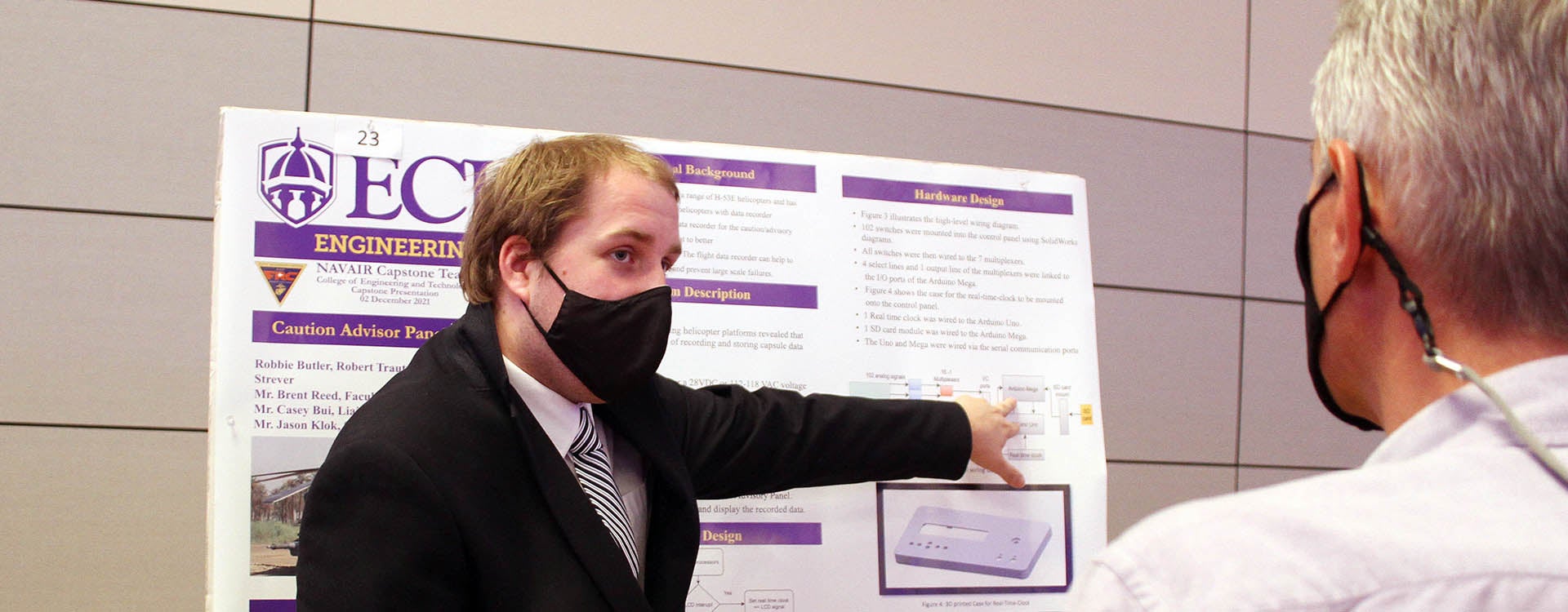CAPPING OFF THE YEAR
ECU engineering students present senior capstone projects
East Carolina University engineering students presented their senior projects during the Fall 2021 Engineering Capstone Symposium at the Main Campus Student Center.
The projects featured everything from aircraft safety measures and health care improvements to dog training devices.
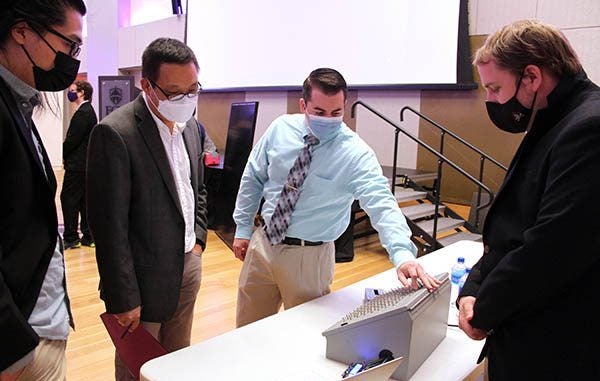
Students Robbie Butler, second from right, and Aaron Strever, right, explain a senior capstone project during the Fall 2021 Engineering Capstone Symposium.
“There’s a pretty wide breadth of projects, and there are a lot of good projects,” said Michael Borer, teaching instructor in the Department of Engineering.
As part of engineering degree requirements, senior students must collaborate on a real-world project that can include everything from design and product development to manufacturing and conservation. The students work directly with industry, businesses or government agencies with guidance from faculty.
The symposium featured 23 teams of students who displayed posters, provided prototypes and talked about the goals and results of their particular projects.
Robbie Butler, Robert Trautman, Jiahao Li and Aaron Strever worked with Fleet Readiness Center East at Cherry Point on a data recorder that would record signals from the caution/advisory panel in an H-53 helicopter and store them for a minimum of 30 days. The helicopters are among the oldest in the military inventory and would need to be retrofitted with the data recorder.
“If the pilot comes back and says several emergency lights came on when we were flying, they can get the SD card, look at the data and determine ‘this went on for this amount of time, or this one just had a slight blip or this went on for three seconds, and we have to check this,’” Strever said.
The team developed a prototype with 102 switches to simulate the caution panel. It was able to record analog signals as well as the times when the warnings happened and store the information on an SD card.
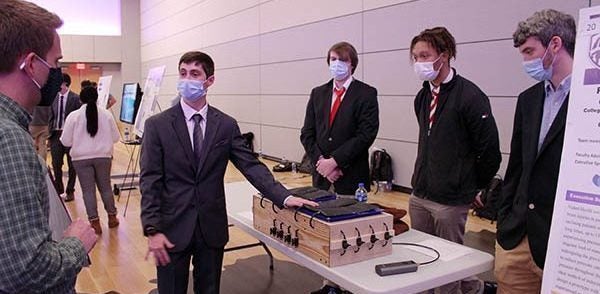
From left, Laken Barnes, Austin Edwards, Dominique Glover and Zack Ellis, talk about their capstone project designed to relieve foot pressure in patients with traumatic brain injuries.
“It’s really a proof of concept,” Strever said of the project. “They wanted us to say, ‘can this be done,’ and then they’ll take over from there.”
Laken Barnes, Dominique Glover, Zack Ellis and Austin Edwards worked with Vidant Health on a device that could help patients with traumatic brain injuries. Barnes explained that some patients are essentially stood up in a special bed to relieve pressure on the brain for a dozen hours or more at a time.
“That can be the difference between whether they live or die,” Barnes said.
However, the method can put pressure on the feet and cause other injuries that impact the patient and be an added expense to treat.
“Imagine standing on a water hose for a really long time and that pressure builds. That’s what’s happening to the vessels in their feet,” Glover said.
Currently, a foam block is used in an attempt to relieve pressure, but the team developed a manual air-inflation method with cushions that proved promising. The team is looking at a more automated electrical system as its next step in the project and is glad to know the project could improve treatment for patients.
“It would feel good to know that we’ve made an impact in eastern North Carolina and possibly beyond if they continue this nationwide,” Barnes said. “Although these are rare cases where someone has very traumatic brain damage, this could impact their lives heavily. If they can come through this and be able to walk again, that would mean the world to us knowing that we can impact their lives in such a great way.”
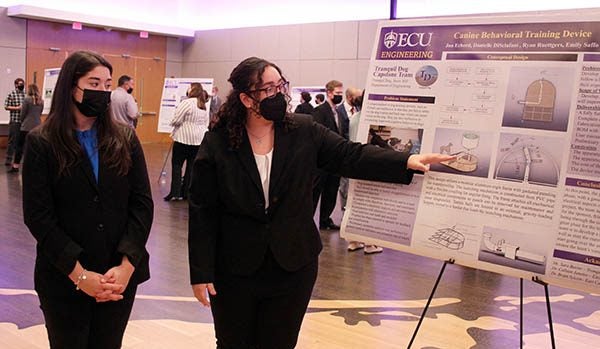
Danielle DiSelafani, left, and Emily Saffo talk about their senior capstone project.
From improving the lives of people to improving the lives of dogs, Jon Echerd, Danielle DiSelafani, Ryan Ruettgers and Emily Saffo worked with the owner of Tranquil Dog in Snow Hill on a training device. The dog actuated tennis ball launcher is designed to reduce the stress on the spine and back legs of dogs as compared to other models.
“It helps train the dog and also promotes the dog-owner relationship,” Saffo said. “It promotes discipline while also giving the dog plenty of exercise because most dogs are full of energy, and it also stimulates their brains because dogs are very intelligent animals.”
The device would launch tennis balls up to 40 feet to the left, right or center of the device, meaning the dog will have to wait to see where the ball goes before chasing it, thus improving its discipline.
“It makes the dog think about where the ball is going to go,” DiSelafani said.
The team worked on a design in the fall semester and plans to develop a prototype this spring.
At the conclusion of the symposium, the fall 2021 graduating students who presented projects received special gifts and posed for a photograph with faculty.
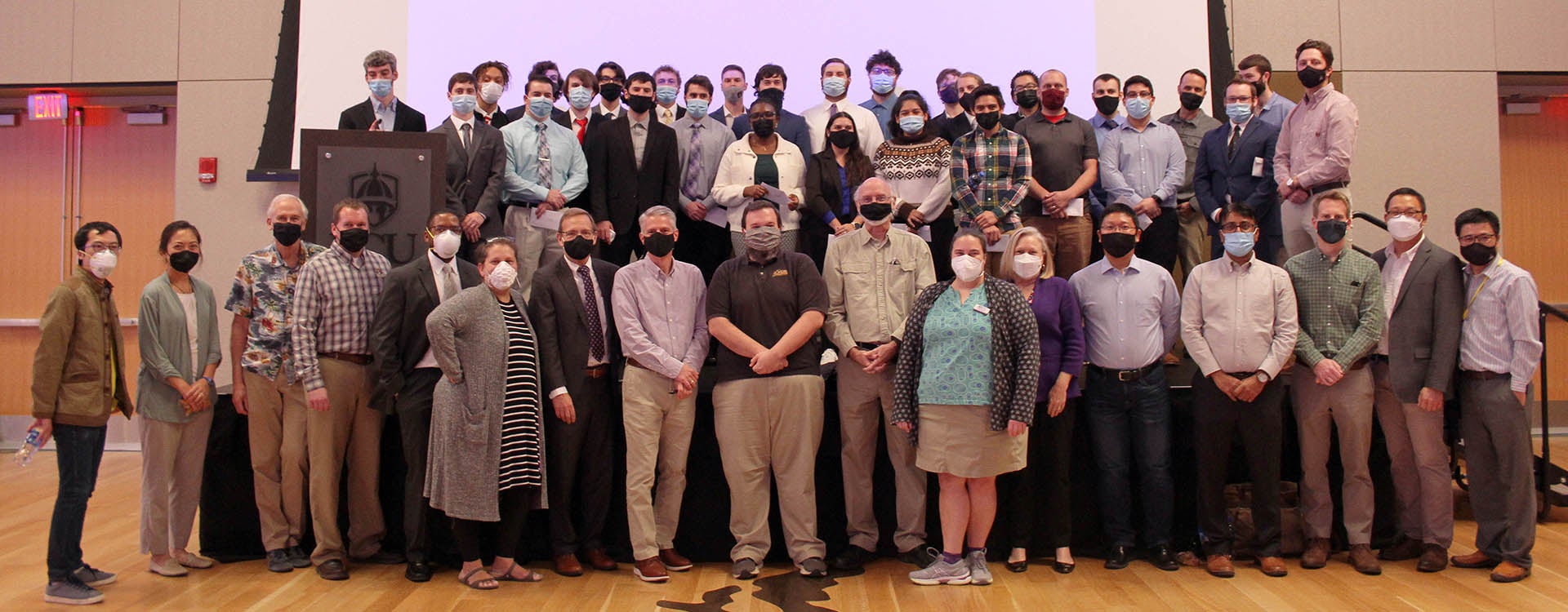
Engineering faculty stand with fall 2021 engineering graduates at the Fall 2021 Engineering Capstone Symposium.
